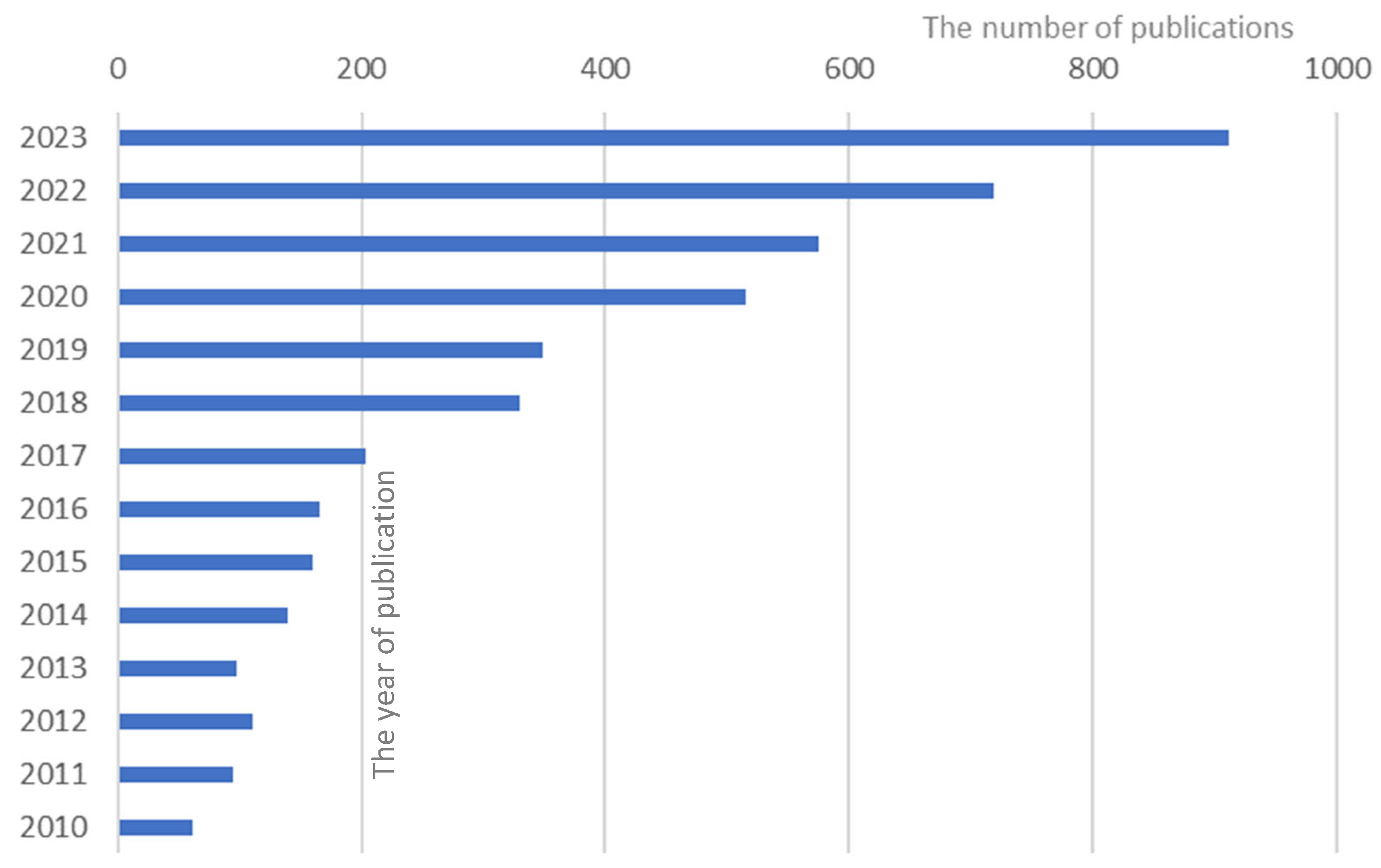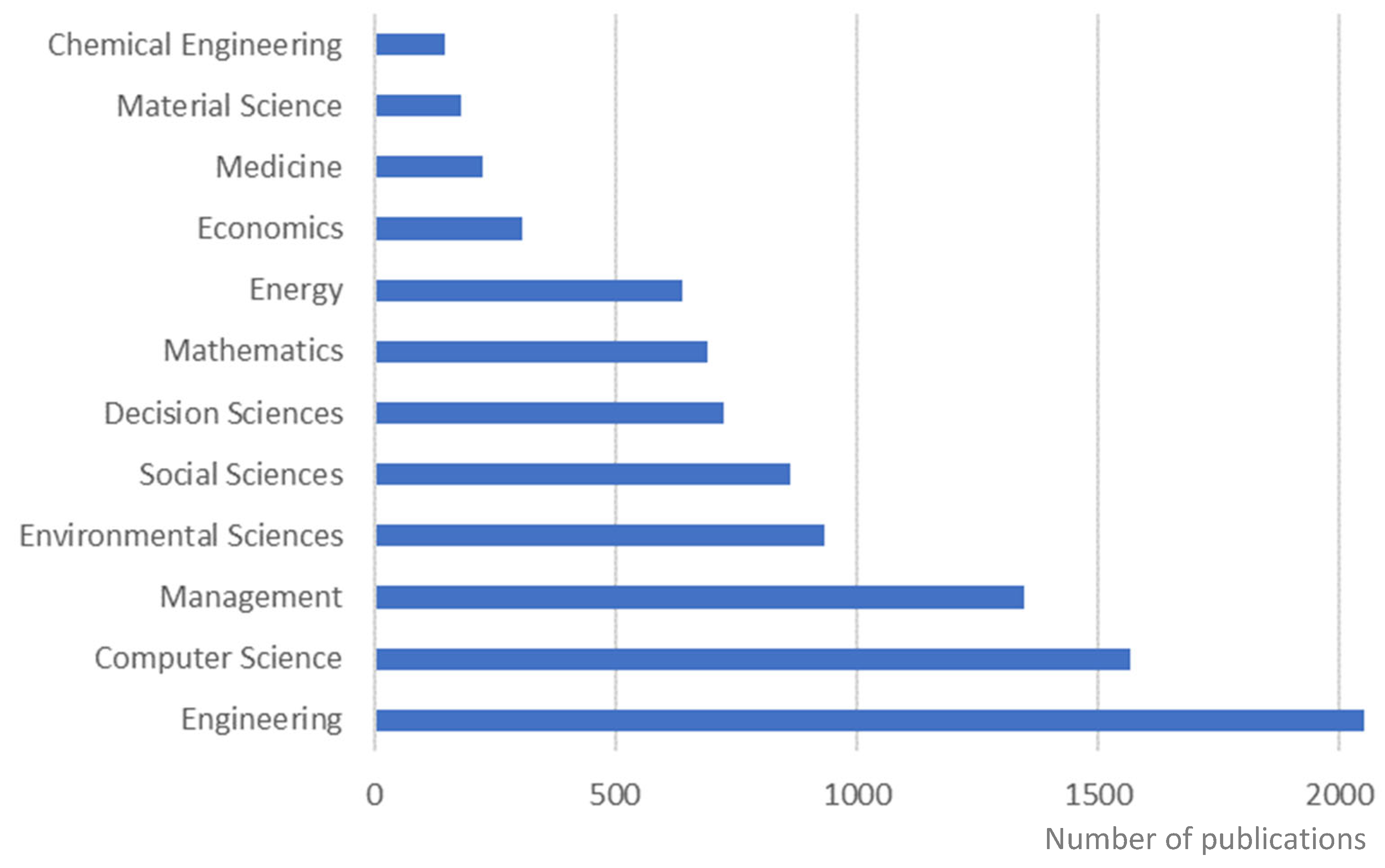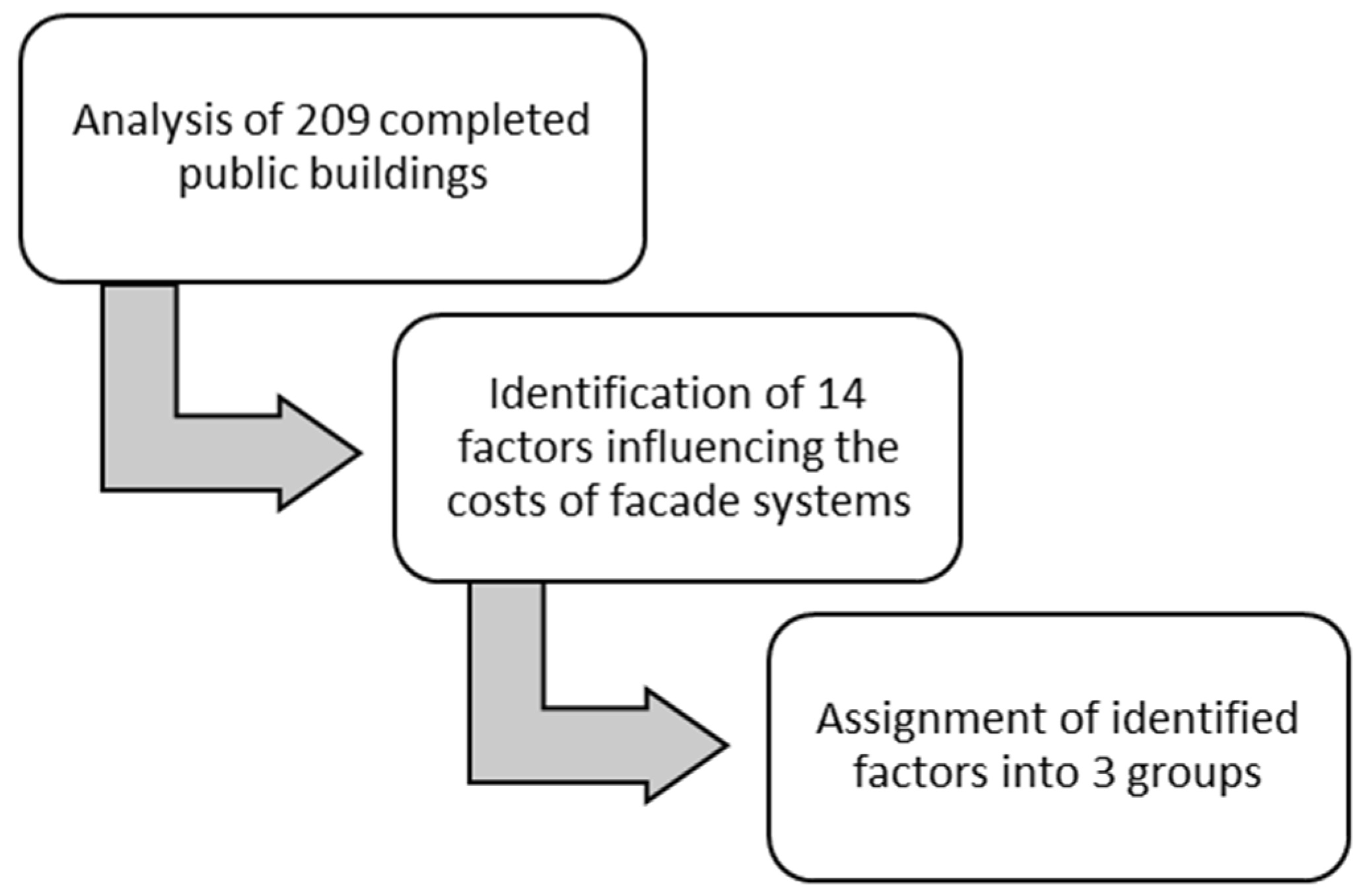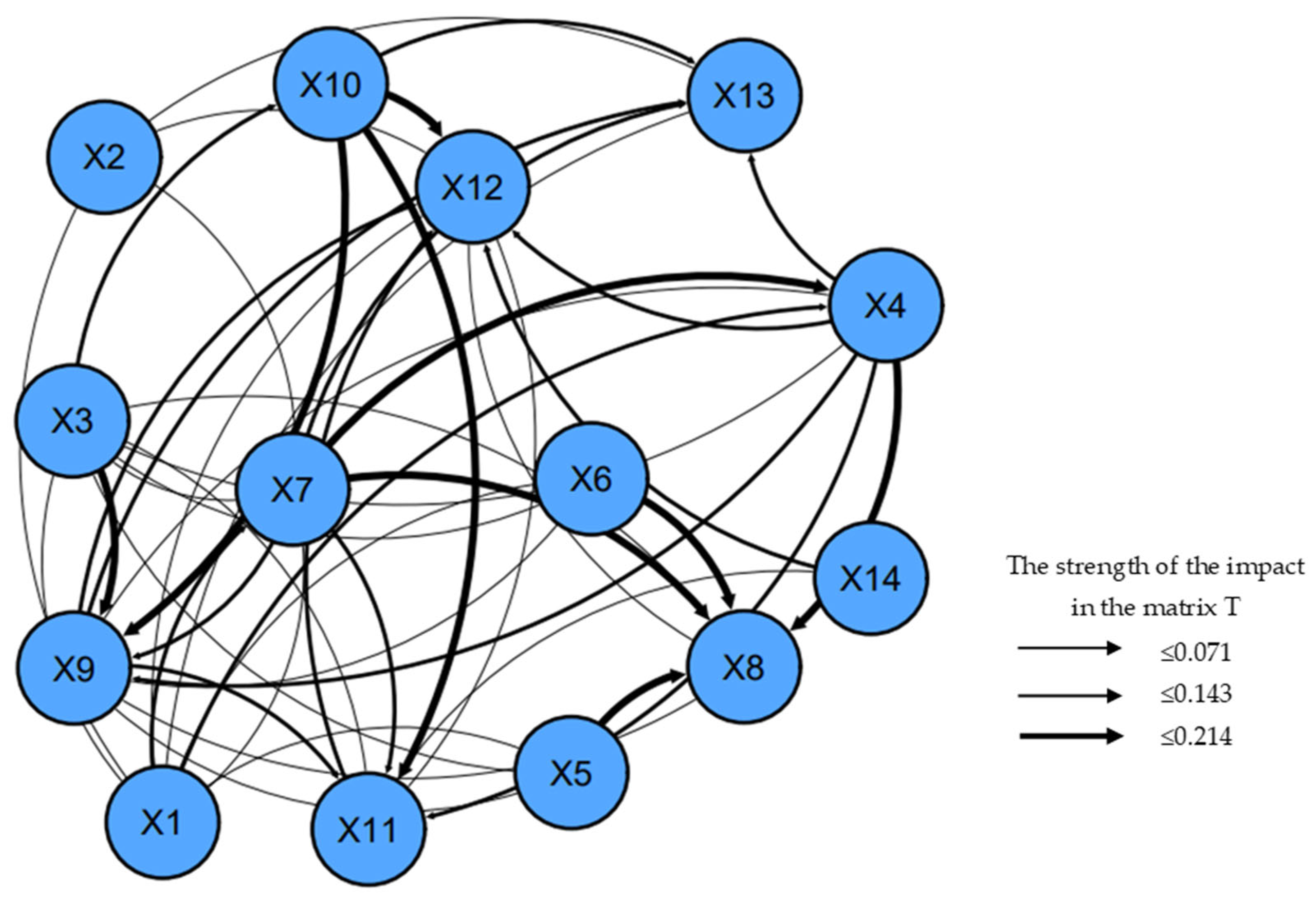The Decision-Making Trial and Evaluation Laboratory Approach to the Assessment and Hierarchy of Factors Shaping the Costs of Facade Systems
Abstract
:1. Introduction
2. Materials and Methods
2.1. The DEMATEL Method
- 0—describes no influence of the first factor on the second;
- 1—slight influence of one factor on another;
- 2 … N − 1—intermediate levels describing the degree of influence of the first factor on the second;
- N—extremely large influence of the first factor on the second.
2.2. Factors Influencing the Costs of Facade Systems
3. Results
- T—total matrix;
- X—normalized form of the direct influence matrix;
- I—identity square matrix.
4. Discussion
- m—number of experts;
- n—number of variants and number of factors assessed by experts.
- S—the sum of squares of deviations for individual sums from the arithmetic mean of the sum of ranks for all n objects.
5. Conclusions
Author Contributions
Funding
Data Availability Statement
Conflicts of Interest
References
- Kasprowicz, T. Engineering of Construction Projects; Wydział Inżynierii, Chemii i Fizyki Technicznej Wojskowej Akademii Technicznej; Poland: Warsaw, Poland, 2002. (In Polish) [Google Scholar]
- Saeedi, M. Study the Effects of Constructions New Techniques and Technologies on Time. Cost and Quality of Construction Projects from the Perspective of Construction Management. J. Civ. Eng. Mater. Appl. 2017, 1, 61–76. [Google Scholar] [CrossRef]
- Sanvido, V.; Grobler, F.; Parfitt, K.; Guvenis, M.; Coyle, M. Critical success factors for construction projects. J. Constr. Eng. Manag. 1992, 118, 94–111. [Google Scholar] [CrossRef]
- Plebankiewicz, E.; Juszczyk, M.; Malara, J. Estimation of task completion times with the use of the PERT method on the example of a real construction project. Arch. Civ. Eng. 2015, 61, 51–62. [Google Scholar] [CrossRef]
- Wieczorek, D.; Plebankiewicz, E.; Zima, K. Model estimation of the whole life cost of a building with respect to risk factors. Technol. Econ. Dev. Econ. 2019, 25, 20–38. [Google Scholar] [CrossRef]
- Anysz, H.; Cuczkowski, B. The association analysis for risk evaluation of significant delay occurrence in the completion date of construction project. Int. J. Environ. Sci. Technol. 2018, 16, 5369–5374. [Google Scholar] [CrossRef]
- Skrzypczak, I. Statistical Quality Inspection Methodology in Production of Precast Concrete Elements. Materials 2023, 16, 431. [Google Scholar] [CrossRef] [PubMed]
- Mrówczyńska, M.; Łączak, A.; Bazan-Krzywoszańska, A.; Skiba, M. Improving energy efficiency with the risk of investment of reference to urban development of Zielona Góra. Teh. Vjesn. 2018, 25, 916–922. [Google Scholar] [CrossRef]
- Zima, K. The case-based reasoning model of cost estimation at the preliminary stage of a construction project. Procedia Eng. 2015, 122, 57–64. [Google Scholar] [CrossRef]
- Castro Miranda, S.L.; Del Rey Castillo, E.; Gonzalez, V.; Adafin, J. Predictive analytics for early-stage construction costs estimation. Buildings 2022, 12, 1043. [Google Scholar] [CrossRef]
- Leśniak, A.; Wieczorek, D.; Górka, M. Costs of facade systems execution. Arch. Civ. Eng. 2020, 66, 81–95. [Google Scholar] [CrossRef]
- Johnson, C.; Adelekan, I.; Bosher, L.; Jabeen, H.; Kataria, S.; Marome, A.W.; Zerjav, B.; Arefian, F. Private Sector Investment Decisions in Building and Construction: Increasing, Managing and Transferring Risks; The UNISDR 2013 Global Assessment Report; UNISDR: Geneva, Switzerland, 2013. [Google Scholar]
- Leśniak, A.; Kubek, D.; Plebankiewicz, E.; Zima, K.; Belniak, S. Fuzzy AHP application for supporting contractors’ bidding decision. Symmetry 2018, 10, 642. [Google Scholar] [CrossRef]
- Ikram, H.A.; Ahmad, M.; Qadeer, R.M.; Nawaz, M. Evaluation of key factors influencing process quality during construction projects in Pakistan. Grey Syst. Theory Appl. 2019, 9, 321–335. [Google Scholar] [CrossRef]
- Hoła, B.; Nowobilski, T. Analysis of the influence of socio-economic factors on occupational safety in the construction industry. Sustainability 2019, 11, 4469. [Google Scholar] [CrossRef]
- Kowacka, M.; Skorupka, D.; Duchaczek, A.; Zagrodnik, P. Identification of geodetic risk factors occurring at the construction project preparation stage. Open Eng. 2019, 9, 14–17. [Google Scholar] [CrossRef]
- Ihara, T.; Gustavsen, A.; Jelle, B.P. Effect of facade components on energy efficiency in office buildings. Appl. Energy 2015, 158, 422–432. [Google Scholar] [CrossRef]
- Besir, A.B.; Cuce, E. Green roofs and facades: A comprehensive review. Renew. Sustain. Energy Rev. 2018, 82, 915–939. [Google Scholar] [CrossRef]
- Thalfeldt, M.; Pikas, E.; Kurnitski, J.; Voll, H. Window model and 5 year price data sensitivity to cost-effective façade solutions for office buildings in Estonia. Energy 2017, 135, 685–697. [Google Scholar] [CrossRef]
- Perini, K.; Rosasco, P. Cost-benefit analysis for green facades and living wall systems. Build. Environ. 2013, 70, 110–121. [Google Scholar] [CrossRef]
- Montero-Parejo, M.J.; Garcia Moruno, L.; Reyes Rodriguez, A.M.; Blanco, J.H.; Garrido Velarde, J. Analysis of façade color and cost to improve visual integration of buildings in the rural environment. Sustainability 2020, 12, 3840. [Google Scholar] [CrossRef]
- Yilmaz, Y.; Yilmaz, B.C. Life cycle cost optimization of building façade: A social housing case. Indoor Built Environ. 2021, 30, 215–228. [Google Scholar] [CrossRef]
- Lee, J.S. Life cycle costing for exterior materials on building façade. J. Constr. Eng. Manag. 2021, 147, 04021059. [Google Scholar] [CrossRef]
- Jin, Q.; Overend, M. A prototype whole-life value optimization tool for façade design. J. Build. Perform. Simul. 2014, 7, 217–232. [Google Scholar] [CrossRef]
- Hadi, E.; Heidari, A. Development of an integrated tool based on life cycle assessment, Levelized energy, and life cycle cost analysis to choose sustainable Façade Integrated Photovoltaic Systems. J. Clean. Prod. 2021, 293, 126117. [Google Scholar] [CrossRef]
- Gholami, H.; Røstvik, H.N.; Kumar, N.M.; Chopra, S.S. Lifecycle cost analysis (LCCA) of tailor-made building integrated photovoltaics (BIPV) facade: Solsmaragden case study in Norway. Sol. Energy 2020, 211, 488–502. [Google Scholar] [CrossRef]
- Leśniak, A.; Górka, M. Analysis of the cost structure of aluminum and glass facades. In Advances and Trends in Engineering Sciences and Technologies III, Proceedings of the 3rd International Conference on Engineering Sciences and Technologies (ESaT 2018), Tatranské Matliare, Slovak Republic, 12–14 September 2018; Al Ali, M., Platko, P., Eds.; CRC Press: Leiden, The Netherlands, 2019; p. 445. [Google Scholar] [CrossRef]
- Bari, N.A.A.; Yusuff, R.; Ismail, N.; Jaapar, A.; Ahmad, R. Factors influencing the construction cost of industrialised building system (IBS) projects. Procedia Soc. Behav. Sci. 2012, 35, 689–696. [Google Scholar] [CrossRef]
- Samarasekara, H.M.S.N.; Purushothaman, M.B.; Rotimi, F.E. Interrelations of the factors Influencing the Whole-Life Cost Estimation of Buildings: A Systematic Literature Review. Buildings 2024, 14, 740. [Google Scholar] [CrossRef]
- Leśniak, A.; Górka, M. Structural analysis of factors influencing the costs of façade system implementation. Appl. Sci. 2020, 10, 6021. [Google Scholar] [CrossRef]
- Dydczak, M.; Przybyło, W. Wielokryterialna ocena systemów transportu Krakowa z użyciem metody DEMATEL. Civ. Environ. Eng. 2011, 2, 241–246. [Google Scholar]
- Zavadskas, E.; Govindan, K.; Antucheviciene, J.; Turskis, Z. Hybrid multiple criteria decision-making methods: A review of applications for sustainability issues. Ekon. Istraživanja 2020, 29, 857–887. [Google Scholar] [CrossRef]
- Dydczak, M.; Ginda, G.; Wojtkiewicz, T. Identyfikacja roli czynników opóźnień realizacji złożonych przedsięwzięć budowlanych. Civ. Environ. Eng. 2011, 2, 481–485. [Google Scholar]
- Dydczak, M.; Ginda, G. Miejsce metody DEMATEL w rozwiązywaniu złożonych zadań decyzyjnych. Zesz. Nauk. Wyższej Szkoły Bank. We Wrocławiu 2015, 15, 631–644. [Google Scholar]
- Fontela, E.; Gabus, A. DEMATEL Observer; DEMATEL 1976 Report; Battelle Geneva Research Center: Geneva, Switzerland, 1976. [Google Scholar]
- Gabus, A.; Fontela, E. World Problems and Invitation to Further thought within Framework of Dematel; Battelle Geneva Research Center: Geneva, Switzerland, 1972. [Google Scholar]
- Tamura, M.; Nagata, H.; Akazawa, K. Extraction and Systems Analysis of Factors That Prevent Safety and Security by Structural Models. In Proceedings of the 41st SICE Annual Conference, SICE 2002, Osaka, Japan, 5–7 August 2002; pp. 1752–1759. [Google Scholar]
- Seyed-Hosseini, S.M.; Safaei, N.; Asgharpour, M.J. Reprioritization of Failures in a System Failure Mode and Effects Analysis by Decision Making Trial and Evaluation Laboratory Technique. Reliab. Eng. Syst. Saf. 2006, 91, 872–881. [Google Scholar] [CrossRef]
- Zhou, D.-Q.; Zhang, L.; Li, H.-W. A Study of the System’s Hierarchical Structure through Integration of DEMATEL and ISM. In Proceedings of the 2006 International Conference on Machine Learning and Cybernetics, Dalian, China, 13–16 August 2006; pp. 1449–1453. [Google Scholar] [CrossRef]
- Śladowski, G.; Paruch, R. Expert cause and effect analysis of the failure of historical structures taking into account factors that are difficult to measure. Arch. Civ. Eng. 2017, 63, 165–186. [Google Scholar] [CrossRef]
- Wałach, D. Analysis of Factors Affecting the Environmental Impact of Concrete Structures. Sustainability 2021, 13, 204. [Google Scholar] [CrossRef]
- Mach, A.; Wałach, D. Implementation of Integrated Life Cycle Design Principles in Ground Improvement and Piling Methods—A Review. Sustainability 2024, 16, 659. [Google Scholar] [CrossRef]
- Gan, X.; Liu, L.; Wen, T.; Webber, R. Modelling interrelationships between barriers to adopting green building technologies in China’s rural housing via grey-DEMATEL. Technol. Soc. 2022, 70, 102042. [Google Scholar] [CrossRef]
- Nilashi, M.; Zakaria, R.; Ibrahim, O.; Majid, M.Z.A.; Zin, R.M.; Farahmand, M. MCPCM: A DEMATEL-ANP-based multi-criteria decision-making approach to evaluate the critical success factors in construction projects. Arab. J. Sci. Eng. 2015, 40, 343–361. [Google Scholar] [CrossRef]
- Ajayi, B.O.; Chinda, T. Impact of construction delay-controlling parameters on project schedule: DEMATEL-system dynamics modelling approach. Front. Built Environ. 2022, 8, 799314. [Google Scholar] [CrossRef]
- Al-gahtani, K.; Alsugair, A.; Alsanabani, N.; Alabduljabbar, A.; Almutairi, B. Forecasting delay-time model for Saudi construction projects using DEMATEL-SD technique. Int. J. Constr. Manag. 2022, 1–15. [Google Scholar] [CrossRef]
- Shooshtarian, S.; Gurmu, A.T.; Mahmood, M.N. Application of the DEMATEL approach to analyse the root causes of building defects. Qual. Quant. 2024, 1–20. [Google Scholar] [CrossRef]
- Gong, C.; Xu, H.; Xiong, F.; Zuo, J.; Dong, N. Factors impacting BIM application in prefabricated buildings in China with DEMATEL-ISM. Constr. Innov. 2023, 23, 19–37. [Google Scholar] [CrossRef]
- Alsugair, A.M.; Al-Gahtani, K.S.; Alsanabani, N.M.; Hommadi, G.M.; Alawashan, M.I. An integrated DEMATEL and system dynamic model for project cost prediction. Heliyon 2024, 10, e26166. [Google Scholar] [CrossRef] [PubMed]
- Zhao, Y.; Mei, D.; Cheng, M. Research on influencing factors of prefabricated construction cost based on DEMATEL. In Advances in Urban Engineering and Management Science Volume 1; CRC Press: Boca Raton, FL, USA, 2022; pp. 344–349. [Google Scholar]
- Ji, Y.; Liu, G.; Qi, Y. Research on identification of influencing factors of prefabrication building cost based on improved Entropy and DEMATEL method. In International Conference on Construction and Real Estate Management; American Society of Civil Engineers: Reston, VA, USA, 2019; pp. 570–576. [Google Scholar]
- Li, L. The analysis on influencing factor of cost control of EPC project based on the DEMATEL-ISM. Staveb. Obz. Civ. Eng. J. 2022, 31, 66–84. [Google Scholar] [CrossRef]
- Si, S.-L.; You, X.-Y.; Liu, H.-C.; Zhang, P. DEMATEL Technique: A Systematic Review of the State-of-the-Art Literature on Methodologies and Applications. Math. Probl. Eng. 2018, 2018, 3696457. [Google Scholar] [CrossRef]
- Li, C.-W.; Tzeng, C.-W. Identification of a Threshold Value for the DEMATEL Method: Using the Maximum Mean De-Entropy Algorithm. Commun. Comput. Inf. Sci. 2009, 35, 789–796. [Google Scholar] [CrossRef] [PubMed]
- Cabała, P. Using the Concordance Coefficient in the Measurement of Agreement among Experts. Przegląd Stat. 2010, 57, 36–52. (In Polish) [Google Scholar] [CrossRef]
- Stabryła, A. Strategic Management in Theory and Practice of a Company; Wydawnictwo Naukowe PWN: Warszawa, Poland, 2005. (In Polish) [Google Scholar]





| Lp. | Factors and Groups of Factors | Symbol |
|---|---|---|
| I | General building characteristics | - |
| I.1 | location | X1 |
| I.2 | type of public utility building | X2 |
| I.3 | building shape | X3 |
| II | Building size description | - |
| II.1 | building height | X4 |
| II.2 | building length | X5 |
| II.3 | building width | X6 |
| II.4 | number of floors | X7 |
| III | Facade Characteristics | |
| III.1 | surface area of the analyzed facade | X8 |
| III.2 | level of facade complexity | X9 |
| III.3 | type of analyzed facade (vertical, curved, sloped) | X10 |
| III.4 | type of aluminum–glass facade | X11 |
| III.5 | type of glass used | X12 |
| III.6 | type of cladding for ventilated facade | X13 |
| III.7 | type of fenestration system | X14 |
| Symbol | Factors and Groups of Factors | Prominence S+ | Relation S− |
|---|---|---|---|
| X1 | location | 0.786 | 0.643 |
| X2 | type of public utility building | 0.286 | 0.143 |
| X3 | building shape | 0.857 | 0.143 |
| X4 | building height | 1.286 | 0.429 |
| X5 | building length | 0.429 | 0.286 |
| X6 | building width | 0.429 | 0.286 |
| X7 | number of floors | 1.214 | 0.786 |
| X8 | surface area of the analyzed facade | 1.071 | −0.786 |
| X9 | level of facade complexity | 1.429 | −0.429 |
| X10 | type of analyzed facade (vertical, curved, sloped) | 1.714 | 0.643 |
| X11 | type of aluminum–glass facade | 1.000 | −0.571 |
| X12 | type of glass used | 1.071 | −0.929 |
| X13 | type of cladding for ventilated facade | 0.714 | −0.714 |
| X14 | type of fenestration system | 0.214 | 0.071 |
| Symbol | Factors and Groups of Factors | Kendall Coefficient | Concordance Assessment |
|---|---|---|---|
| X1 | location | 0.794 | plus good |
| X2 | type of public utility building | 0.519 | good |
| X3 | building shape | 0.985 | perfect |
| X4 | building height | 0.892 | good |
| X5 | building length | 0.794 | plus good |
| X6 | building width | 0.728 | plus good |
| X7 | number of floors | 0.888 | very good |
| X8 | surface area of the analyzed facade | 0.672 | plus good |
| X9 | level of facade complexity | 0.729 | plus good |
| X10 | type of analyzed facade (vertical, curved, sloped) | 0.829 | very good |
| X11 | type of aluminum–glass facade | 0.682 | plus good |
| X12 | type of glass used | 0.497 | good |
| X13 | type of cladding for ventilated facade | 0.567 | good |
| X14 | type of fenestration system | 0.839 | very good |
Disclaimer/Publisher’s Note: The statements, opinions and data contained in all publications are solely those of the individual author(s) and contributor(s) and not of MDPI and/or the editor(s). MDPI and/or the editor(s) disclaim responsibility for any injury to people or property resulting from any ideas, methods, instructions or products referred to in the content. |
© 2024 by the authors. Licensee MDPI, Basel, Switzerland. This article is an open access article distributed under the terms and conditions of the Creative Commons Attribution (CC BY) license (https://creativecommons.org/licenses/by/4.0/).
Share and Cite
Górka-Stańczyk, M.; Leśniak, A. The Decision-Making Trial and Evaluation Laboratory Approach to the Assessment and Hierarchy of Factors Shaping the Costs of Facade Systems. Buildings 2024, 14, 1780. https://doi.org/10.3390/buildings14061780
Górka-Stańczyk M, Leśniak A. The Decision-Making Trial and Evaluation Laboratory Approach to the Assessment and Hierarchy of Factors Shaping the Costs of Facade Systems. Buildings. 2024; 14(6):1780. https://doi.org/10.3390/buildings14061780
Chicago/Turabian StyleGórka-Stańczyk, Monika, and Agnieszka Leśniak. 2024. "The Decision-Making Trial and Evaluation Laboratory Approach to the Assessment and Hierarchy of Factors Shaping the Costs of Facade Systems" Buildings 14, no. 6: 1780. https://doi.org/10.3390/buildings14061780
APA StyleGórka-Stańczyk, M., & Leśniak, A. (2024). The Decision-Making Trial and Evaluation Laboratory Approach to the Assessment and Hierarchy of Factors Shaping the Costs of Facade Systems. Buildings, 14(6), 1780. https://doi.org/10.3390/buildings14061780







